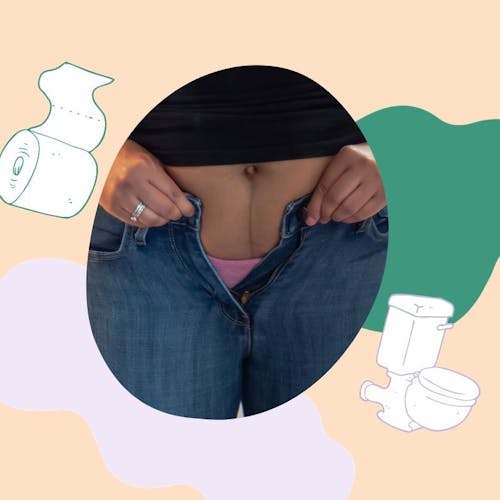This website uses cookies to enhance the user experience. By using Yoppie you are agreeing to our use of cookies.
Vaginal Tightness: Everything You Need To Know About The Pelvic Floor
Written by Yoppie
22 Jan 2021
What is the pelvic floor?
How do I know if my pelvic floor muscles are dysfunctional?
Why should I care about my pelvic floor muscles?
What the heck are Kegels?!
What other exercises can I do for my pelvic floor?
Does my age matter?
If you’re wondering what this pelvic floor thing is that everyone’s talking about, you’re in the right place. Here we’re breaking down what the pelvic floor actually is, how to keep it strong, and why we need to ignore the cultural messaging that tells us ‘keeping it tight’ down there is the only way to keep the pleasure in sex (it’s not). Let’s dive in!
What is the pelvic floor?
Your pelvic floor is a group of muscles and ligaments that support the uterus, bladder and bowel inside your pelvis. Keeping those muscles tight will ensure those organs sit where they’re supposed to sit. You will be able to feel your pelvic floor muscles in action if you try stopping the flow of urine when peeing (although don’t do this often as it can stress your bladder!).
How do I know if my pelvic floor muscles are dysfunctional?
The signs of an issue with the pelvic floor muscles include getting urges to use the bathroom suddenly or constantly, accidental urine leaks when exercising, coughing or even laughing, accidentally passing wind. A weakness in the muscles of the pelvic floor can lead to prolapse (when one or more organs in the pelvis move down from their normal position and bulge into the vagina). A general sign of a weak pelvic floor is if you are having trouble holding your urine throughout the day, or experience accidental leaks. If the pelvic floor is excessively tight or contracts unintentionally, it can cause pain during sex or pain in the pelvic area.
Why should I care about my pelvic floor muscles?
The short answer is, if they’re healthy and doing their job, you don’t really need to care about them at all. There are unfortunately many societal myths that suggest the tightness of your vagina is directly related to sexual pleasure for both you and your partner, and many products and even surgeries are advertised to help achieve ‘the perfect vagina’, which of course, doesn’t exist. Pleasure during sex is multifactorial, and not entirely down to how tight someone’s vagina is, so you shouldn’t feel ashamed or embarrassed by this.
Most people find that weak pelvic floor muscles only become a problem later in life or after childbirth, but if you do experience issues, don’t be afraid to speak to your GP for an assessment, and don’t brush the symptoms off. There are many available options that can help, with treatment ranging from physiotherapy to surgery.1 Many feel that as they get older or after they have had children this is something they simply need to live with, but that’s not always the case.
What the heck are Kegels?!
If you are experiencing weak pelvic floor muscles, or you’re worried about them in future, you’ll be pleased to know that just like other muscles in the body, your pelvic floor muscles can be worked out, too - anyone else imagining a gym for your vagina? No? Just us?
Let’s get into the exercises you can do to help strengthen your pelvic floor. One such exercise many people love to do (and many TV shows love to reference) is the Kegel exercise, which is another name for pelvic floor exercises. The great thing about doing Kegels is that you can pretty much do them any time, any place, and the people around you will be none the wiser.
To do this, engage your pelvic floor muscles (remember holding your urine stream mid-flow? Them's the ones!) and hold for 5-10 seconds, then release. While you’re holding, try not to hold your breath or tighten your stomach muscles. Repeat this another 5-10 times, and do this a few times each day. There’s really nothing to it, and if you’re worried you’ll forget, there are tons of apps that will discreetly remind you at regular intervals. The NHS recommends the Squeezy app and it is also endorsed by the Royal College of Obstetricians and Gynaecologists and can be used by anyone who wants to practice working their pelvic floor.
What other exercises can I do for my pelvic floor?
Aside from focused pelvic floor exercises, simply doing some strength training on the muscles in the lower half of your body can help. Things like squats and some yoga poses can help target the area and keep you generally healthy. If you want some more pelvic floor strengthening exercises to try, here are 5 easy poses.
Does my age matter?
Age is just a number, but try telling that to your pelvic floor muscles! They have a habit of relaxing over the years, and while everyone’s experience of this will be different (there are plenty of post-menopausal women with healthy pelvic floors!), in general it is known that your muscles change as you age.
In your 20s, the pelvic floor is at its prime. Some women even find theirs can be too tight during intercourse or when inserting a tampon. Although women may notice some weakening after childbirth, it is usually temporary at this age, and returns to similar strength soon after. In your 30s, a slight decrease in pelvic floor strength can occur, and if you give birth in your 30s, things could take slightly longer to strengthen than in your 20s.
In your 40s, decreases in estrogen lead to a decreased blood supply to the vagina, which can cause physical and aesthetic changes to your vagina, and you may experience more strain on the pelvic floor muscles. After the menopause, usually around the age of 50, you may experience further weakening of the pelvic floor muscles, but in all cases it’s important to know there are many options to help relieve some of the symptoms and even re-strengthen the muscles, such as medications, pessaries, physical therapy, and more.
If weak pelvic floor muscles are affecting your daily life, speak to your doctor to see what options you have. Got questions about pelvic floor muscles? Head on over to our private Facebook group or drop us a note on Insta @itsyoppie. Don't forget that our personalised period subscription box can get organic tampons, pads, liners (and more) delivered easily and regularly through your letterbox. That's one less thing to need to tense up about.

References
1. NICE Guideline: Urinary incontinence and pelvic organ prolapse in women: management. NICE 2019; 3–72.
2. Bladder And Bowel Foundation. Pelvic Floor Exercises For Womenwww.bladderandbowelfoundation.org (2008, accessed 28 January 2021).
3. Mukhopadhyay S, Morris E, Arulkumaran S, et al. APP REVIEW Squeezy-the NHS Physiotherapy App for Pelvic Floor Muscle Exercises. Obstet Gynaecol. Epub ahead of print 2016. DOI: 10.1111/tog.12272.
4. Cody J, Hextall A, et al. Oestrogen therapy for urinary incontinence in post-menopausal women. Cochrane Database Syst Rev. Epub ahead of print 2012. DOI: 10.1002/14651858.CD001405.pub3.
Section jump
Back to top
Subscribe To Our Newsletter
YOPPIE





© 2026 Yoppie is a registered trademark of Phlo Technologies Ltd.
Yoppie's supplements are not a substitute for a varied diet and healthy lifestyle and are not intended to diagnose, treat, or cure any disease. If you are pregnant, breastfeeding, have a medical condition or are under medical supervision, please consult with your doctor before taking any of our products.






